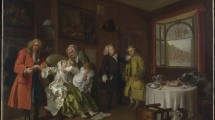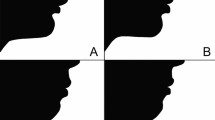Key Points
-
Sir John Lavery's portrait of The Dentist (Conrad Ackner and his Patient) is an unusual departure for a painter renowned for his portraits of the contemporary celebrities.
-
It shows its subject in action. His patient, Hazel Lavery, one of the great beauties of the day, is partially obscured.
-
Lavery's depiction of dentists' equipment gives us an almost unprecedented view of a surgery of the 1920s.
Abstract
The rise of the dental profession coinciding with the invention and rapid spread of photography means that there are very few paintings of dentists in action. The present article describes Sir John Lavery's unusual depiction of The Dentist (Conrad Ackner and his Patient) in which the conventions of contemporary society portraiture are set aside. The resulting canvas has much to tell us about the up-to-date equipment used in a surgery of the late twenties by a successful practitioner who pioneered the use of X-rays.
Similar content being viewed by others
Log in or create a free account to read this content
Gain free access to this article, as well as selected content from this journal and more on nature.com
or
References
McConkey K . John Lavery, a painter and his world. pp 166–174. Edinburgh: Atelier Books, 2010.
Robins Pennell E . The life and letters of Joseph Pennell. Volume 2. p 340. London: Little, Brown and Co, 1930.
McConkey K . John Lavery, a painter and his world. pp 125–127. Edinburgh: Atelier Books, 2010.
McConkey K . John Lavery, a painter and his world. p 62. Edinburgh : Atelier Books, 2010.
Royal Society of Portrait Painters. Thirty-Eighth Annual Exhibition, November 1929, no. 138, as The Dentist.
Unidentified press cutting in The 'Bluebook', a scrapbook presented to Dr Ackner by his staff, 1938, Private Collection.
McConkey K . John Lavery, a painter and his world. pp 192–194. Edinburgh: Atelier Books, 2010.
Carr-Saunders A M, Wilson P A . The professions. p 112. Oxford: Oxford University Press, 1933.
Carr-Saunders A M, Wilson P A . The professions. pp 113–115. Oxford: Oxford University Press, 1933.
McConkey K . John Lavery, a painter and his world. pp 147–149. Edinburgh: Atelier Books, 2010.
Claudius Ash, Sons and Co Ltd. Dental supplies catalogue, 1928. p F48
Dental Manufacturing Co. Catalogue, 1928. p 42.
Claudius Ash, Sons and Co Ltd. Dental supplies catalogue, 1928. pp C4–C7.
Victor X-Ray Corporation. Model “CDX” Dental X-Ray Apparatus, Bulletin 260, n. d., 212 Jackson Boulevard, Chicago.
Cogeval G et al. Edouard Vuillard, 2003. Exhibition catalogue, National Museum of Art, Washington and Montreal Museum of Fine Arts. pp 348–349.
Thomson B . Vuillard. pp 131. Oxford: Phaidon, 1988.
Roger-Marx C . Vuillard, his life and work. pp 117–118. London: Paul Elek, 1946.
Acknowledgements
I am most grateful to Anthony Ackner and Rachel Bairsto for their assistance in the preparation of this article.
Please help the BDA Museum acquire this important painting of a fashionable London dental practice. 'The Dentist' by Sir John Lavery depicts Conrad Ackner in his surgery at 47B Welbeck Street in 1929. Museum needs to raise £60,000 and is hoping to raise the majority of funds from the V A/MLlA Purchase Grant Fund and Art Fund. If successful with these grants we would need to contribute approximately £12,000.
A/MLlA Purchase Grant Fund and Art Fund. If successful with these grants we would need to contribute approximately £12,000.
We gratefully acknowledge the donation of £1,000 from the Lindsay Society for the History of Dentistry to kickstart our campaign.
To make a donation or for further details, please contact Rachel Bairsto at the museum on 020 7563 5832/4549 or r.bairsto@bda.org. Further information about the painting can be found at www.bda.org/lavery.
The BDA Museum is part of the BDA Ttrust Fund and a registered charity No 313407. If you are a UK tax payer we are able to maximise your donation through gift aid.
For an opportunity to view the painting 'The Dentist' by Sir John Lavery please visit the BDA library where it is on display.
Author information
Authors and Affiliations
Corresponding author
Additional information
*Conrad Adolph Achner (later re-styled as 'Ackner,' 1880-1975) was the son of Heinz Achner. He may have changed the spelling of his surname during the Great War. Ropcha, his place of birth, was then part of the Austro-Hungarian Empire. It later became part of Rumania and is now part of the Ukraine. The author is grateful to Anthony Ackner for notes on his grandfather's early career. ‡Ackner's experience of examining over 300 cases at Guy's was reported in a paper entitled 'X-ray observations on abscesses, cysts and root resections', Transactions of the XIth International Dental Congress, 1914, pp 299–305. In these cases Ackner argued for 'the great importance of removing the entire root in extraction, and of also scraping out the granuloma or abscess cavity, and thus preventing further complications...' (p. 305). A year later, Ackner reported on his design of a 'Maxillary Splint' for use in cases of jaw fracture (extract from The Lancet, reported in British Dental Journal 1915; 36: 205–206). This improved on earlier designs, maintaining immobility in the broken bone while permitting normal movement. §Raphael Tuck was born in East Prussia but emigrated to London in 1865 with his wife and seven children. He opened a framing business and within five years had expanded into publishing Christmas cards. The business prospered and received the Royal Warrant in 1893. Rhoda Tuck, one of Raphael's grandchildren, married Ackner and had four sons, Derek, Brian, Desmond (later Lord Ackner) and John. ||Sir John Weir KCVO, (1879-1971) was appointed physician to King George V in 1918 and remained in the Royal Household through the reigns of Edward VIII, George VI and Elizabeth II. He retired in 1968. He and Ackner were close friends, going on motor tours together in Ackner's Bentley. ¶Sir Patrick Ford MP (1880-1945) represented Edinburgh North until 1935 and held the post of Solicitor General for Scotland. He organised a Lavery retrospective in Dundee in 1936. Lavery painted his and his mother's portraits in the early years of the century and the two became friends, especially when after the Great War, Ford would stage weekend parties at his villa at Westerdunes, on the outskirts of North Berwick. #For The Blacksmiths of Tramore, The Fine Art Society, London, see McConkey 2010, p.165, (Figure 196); the Interior at Lennoxlove, 1921 is in a Private Collection; while The Golf Links, North Berwick, 1921 (sold Christie's Scotland, 31 October 2002) relates to a large work, Playing Golf at North Berwick, which was shown at the Glasgow Institute of the Fine Arts in 1922. This shows the artist's step-daughter, Alice, teeing-off in the presence of the Fords, Asquith and Hazel Lavery. **Lavery first visited Tangier in 1891. He purchased a house in the hills to the south of the Medina, overlooking the Straits of Gibraltar in 1903. Known as Dar-el-Midfah, the 'House of the Cannon', it had a rusty cannon in the garden which remains to this day. The house functioned as a winter studio, a base for desert forays and a trip to Fez in 1907. Its extensive garden, with tumbling bougainvilleas, was painted on many occasions. The Gardener's Daughter was sold Christie's, 12 June 1986.
Rights and permissions
About this article
Cite this article
McConkey, K. Sir John Lavery's The Dentist (Conrad Ackner and his Patient). Br Dent J 210, 81–85 (2011). https://doi.org/10.1038/sj.bdj.2011.4
Accepted:
Published:
Issue date:
DOI: https://doi.org/10.1038/sj.bdj.2011.4
This article is cited by
-
Dental care in modern art (1914–2014)
BDJ (2017)
-
'The Dentist's Hands': An analysis of the portrait by Fiona Graham-Mackay
British Dental Journal (2016)
-
Dental art: Students analyse historic practices through art
British Dental Journal (2014)



